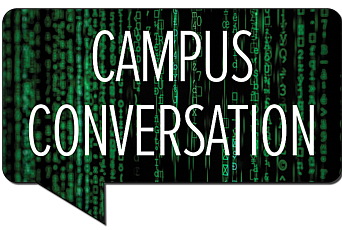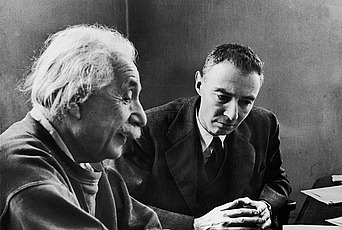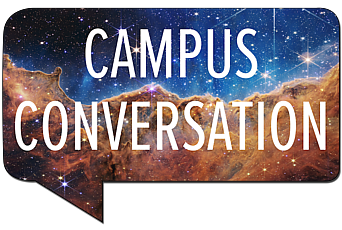
IAS Scholars on "Our Oppenheimer"
April 2022 saw Hollywood come to the Institute. Cillian Murphy, Emily Blunt, Robert Downey Jr., Tom Conti, and other big names visited campus to shoot scenes for Christopher Nolan’s Oppenheimer biopic, a film based on the life and complex legacy of past IAS Director J. Robert Oppenheimer. Many iconic IAS locations were transformed for the occasion: Fuld Hall Common Room received a 1950s makeover and the Institute Woods and pond were another hive of activity. In the film, the pond, the construction of which took place during Oppenheimer’s directorship, formed the setting for conversations between Oppenheimer and founding IAS Professor Albert Einstein.
Prior to and during filming, members of IAS staff helped to support the production team. Staff from the Institute’s Shelby White and Leon Levy Archives Center played a key role, providing archival images of key filming locations to aid with the historical accuracy of the set dressing. The arrival of the film crew on campus and the subsequent release of the movie in July 2023 also generated significant excitement among IAS scholars.
The following comments from Members and Visitors across all four IAS Schools provide insight into what it was like to share the campus with the production team, as well as highlighting our community's reactions to the film:
"'Robert Downey Jr. is improvising,' the assistant director declared, walking up to the assemblage of IAS staff and members standing outside Fuld Hall as the extras and production assistants milled about. 'He needs to know what you called the tea room in 1948.' It was the moment I had long awaited: a chance to make a major contribution to the history of physics merely by looking something up on my phone. A few seconds later…success: the original blueprints, and a name: 'Common Room.' My colleagues in Communications, chasing down their sources, confirmed it. Robert Downey Jr.’s line would stay, and history would forever remember Lewis Strauss offering J. Robert Oppenheimer tea and cookies in the Common Room at 4pm. After decades in academia, I had finally fulfilled my life’s ambition and, in the process, rescued a major international motion picture production from possible disaster."
Matthew Hersch
Visitor (2020–21), School of Historical Studies
"One small detail I particularly enjoyed in Oppenheimer was a conversation between Oppenheimer and his student, Hartland Snyder, about their work on gravitational contraction (which led to a paper famously published on the same day that Germany invaded Poland). This paper was one of the first to identify that a collapsing star will form a singularity, if its mass exceeds a certain threshold. A first estimate for that threshold was worked out earlier the same year, in a pair of papers by Oppenheimer and his student George Volkoff and by Caltech professor Richard Chace Tolman (who also featured in the movie). Now referred to as the Tolman-Oppenheimer-Volkoff (TOV) limit, this provides the dividing mass between whether an object can stably exist as a neutron star, or whether it must collapse to a black hole. My own research focuses on the structure of neutron stars and the TOV limit is an essential—but still uncertain!—piece of this puzzle."
Carolyn Raithel
John N. Bahcall Fellow (2020–24), School of Natural Sciences
"While the cast was on a filming break, I found myself engaged in conversation with Robert Downey Jr. I took the opportunity to convey our enthusiasm about meeting the film's cast and hosting them at the Institute. What struck me was his response, which made me realize that they shared our excitement! Evidently, each of them had delved into the history of Oppenheimer and the Institute, and they were eager to explore the very location where those significant events unfolded. Robert Downey Jr. exhibited genuine interest in my ongoing research, even though my work on algorithms is not as flashy as the science being carried out in the film!"
Or Zamir
Member (2021–22) and Visitor (2022–23), School of Mathematics

"As I sat in an Italian movie theater to see Oppenheimer, just like its protagonist I felt torn by dilemma. I experienced a feverish alternation of conflicting feelings and judgments. On the one hand, I felt a sense of discomfort over several aspects, both ethical and cinematographic; on the other, I felt very strongly the emotion of seeing one of the places—if not the place—that I cherish the most in the world, the Institute, on the big screen.
For obvious reasons, I do not feel ready to entrust my understanding of crucial historical events to a movie. Especially these ones. But I am ready instead, despite my discomfort, to recognize in Nolan’s work something fundamental: the power that only great art has to profoundly destabilize us in our beliefs, visions, and feelings, for better or worse. It is something to be grateful for."
Lorenzo Alunni
Wolfensohn Family Member (2022–23), School of Social Science
"One of the things that I found most special about the movie was that I could connect with many of its characters: I'd been following them professionally for decades. One such figure was Philip Morrison, who was a professor at MIT when I was a graduate student, and with whom I almost worked for my PhD thesis. Morrison is one of the founders of gamma-ray astronomy, which looks for radioactive species using their gamma-ray emissions. During the Manhattan Project, he was responsible for bringing the pit of plutonium to the Trinity test site. He once related to me how he had placed the pit in its box, feeling the warmth of the plutonium in his hands. He assured me that the radioactivity was modest because the pit was nickel-plated, but his description resonated with me as I watched this same scene unfold in the movie."
Adam Burrows
Member (2023–24), School of Natural Sciences
"In attempting to describe my year as a Member at IAS to curious friends and family, I was often met with a mixture of confusion and disbelief. The total freedom to pursue interesting ideas and the liberation from teaching and other commitments seemed improbable enough, but when I began to describe the pond and Woods, long lunches and teatime, as well as the presence of innumerable brilliant colleagues, their brows furrowed. It simply seemed too good to be true. Was my imagination just running away with me? Since Oppenheimer, though, the site of my stories has become a real location, a place where famous actors pretending to be famous scientists once strolled. 'The place from the movie,' they now exclaim. 'Looks nice!'"
Whitney Laemmli
Andrew W. Mellon Foundation Fellow (2021–22), School of Historical Studies
"During filming, Simonyi Hall, where the School of Mathematics is based, became known as a particularly good spot for meeting the movie people. When they were shooting at the pond, one could see what was going on through the big glass window at the entrance. For a few days, I was taking occasional strolls through this building to check on the filming progress. On one occasion, I was walking out of a colleague’s office and saw a man in a period costume coming toward me. He looked both familiar and really out of place. It was Robert Downey Jr.! Startled, I exclaimed something like “Oh, hello!”. He said “hello!”, made this exaggerated Middle Ages style theatrical bow, and continued on his way. The production crew also did impressive work with making the Institute look like it did in the 1940s. They even changed every door handle in Fuld Hall!"
Elena Murchikova
Member (2018–22) and Visitor (2022–23), School of Natural Sciences

"While at the Institute, I occupied an office that once belonged to Albert Einstein. It stood in for the director’s office in the movie. For months before the filming, I had crew members stopping by to check the lighting, the view of the gardens, and admire the wonderful space. They were always very pleasant people, living in their own world (“I just came from a shooting in NY with J.Lo!”). At the same time, they treated me with a certain reverence, and were somewhat disappointed to learn that I was not the director and I was not working on top secret projects like Oppenheimer. Of course, they must have figured that even if I was, I would not tell them. After one visit from the crew, I returned to my office to see “Thanks! C. Nolan” written on my blackboard. (I left it for several weeks and my visitors even took photographs of it.) The date it appeared, however, was April 1!"
László Székelyhidi
Member (2003–04) and Distinguished Visiting Professor (2021–22), School of Mathematics


